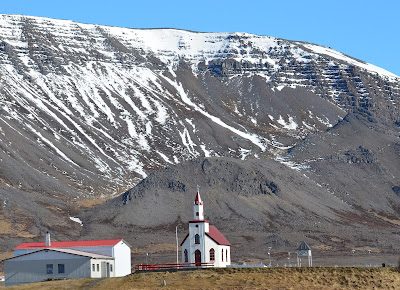We drove over Brattabrekka pass and to the N1 gas station in Búðardalur, which we can always rely on to be open with clean restrooms. We then headed up to the peninsula and out along its southern shores, which are called the Fellsströnd. The Saga of the People of Laxárdal is about this region and other areas around Hvammsfjörður. After stopping to read some of the roadside signs about the history of the area, I became much more interested in reading that saga. The drive was mostly uneventful, except for one point when we almost got the car stuck on a road that had washed out a bit much for the low suspension of the otherwise surefooted Corolla.
We took a double track trail to see a church at Dagvarðarnes, which is almost at the western-most tip of the peninsula. This specific location was also mentioned in the sagas. It was very serene and remote. Later on, we learned that the church and the neighboring house are owned by the family of Kristín, who is a member of the staff at Bifröst and the mother of Joslyn's friend, Jóhanna. We talk to Kristín occasionally while we are having coffee in the mornings, and she waxed poetic about viewing the sunsets from Dagvarðarnes. I could imagine that they are quite spectacular, since Breiðafjörður and the open ocean lie off to the west and cliffs and snow-capped mountain surround the site on the other three sides.
 |
| Far off in the distance is the Látrabjarg cliff of the West Fjords, the westernmost point of Iceland. |
We drove back to the main road and continued on around the peninsula. After only a couple miles, we stopped where the road cut through the Klofningur mountains and climbed to a viewpoint next to the road. From this vantage point we could see the entire northern coast of the Snæfellsnes peninsula and most of the southern coast of the West Fjords. As we have found at many of the easily accessible viewpoints around Iceland, a viewing dial had been placed at the site. It listed the names of mountains, churches, and towns that could be seen from the point and the distances to them. It also stated the elevation of the mountains. It was very useful for us, because we could see a great distance in all directions. The views were absolutely spectacular!
 |
| A view to the east of Fellsströnd. |
 |
| A juvenile white-tailed eagle. |
 |
| The juvenile and one of the adult white-tailed eagles show off their six foot wingspans. |
 |
| Staðarhólskirkja, at the northern base of the peninsula. |
The eagles finally flew off and we drove on down Skerðsströnd back to base of the peninsula. We crossed Gilsfjörður thereby officially setting foot in the West Fjords. However, we were running out of time, so we crossed back over and had dinner at a roadside restaurant before heading for home. As we started inland to cross back over Brattabrekka, we saw that the dairy Erpsstaðir was open for business. It is only open four hours in the afternoons on Fridays and Sundays, so we figured we were pretty lucky to catch it while it was open and pulled in to see what was available. It turned out to be the most modern dairy I have ever seen. A large glass window in the store allowed us to watch the cows get run through a robotic milking machine. It opened the gate, the cow walked in, a scanner read her ear tag, feed was dumped into a trough in front of the cow, her teats were washed, and the robot attached each of the milkers to the udder. A computer screen allowed us to watch as the amount of milk was measured. One cow produced 10 liters of milk before the system sensed that she was done and pulled off the milkers. Then, the process repeated itself without a person being present at all! The owner showed up while we were busy being fascinated by the whole process and we bought some ice cream, skyr, and cheese. We ate the ice cream on the benches in front of the building and then drove on home. Since we got home in the late afternoon, everyone had time to wind down and relax before going to bed.






No comments:
Post a Comment